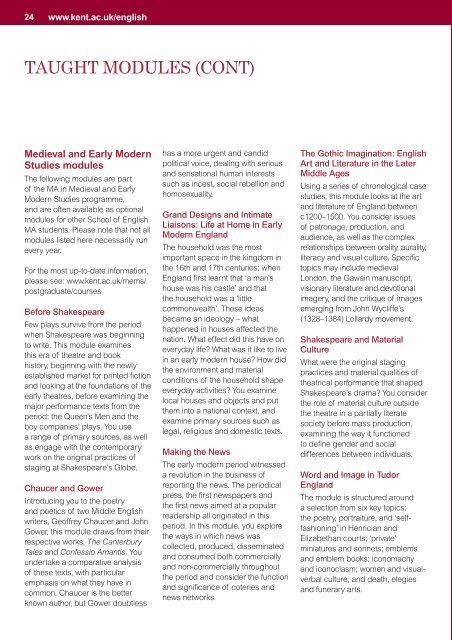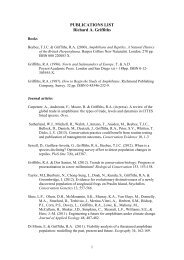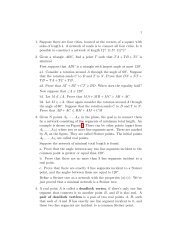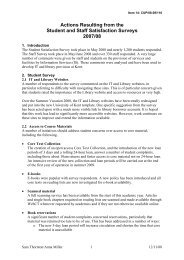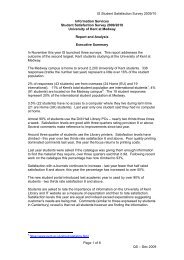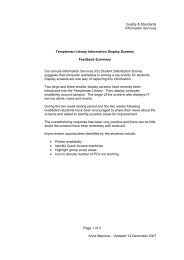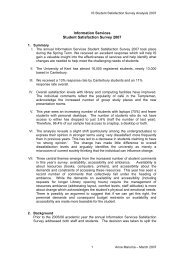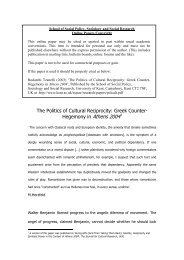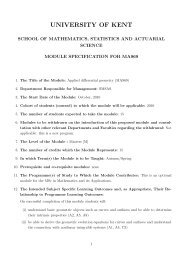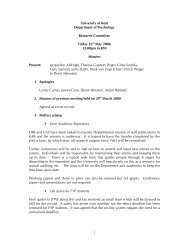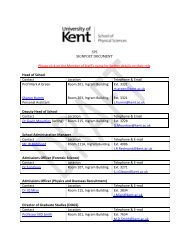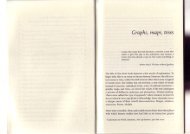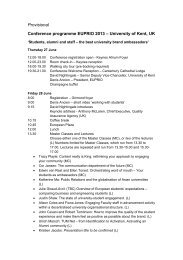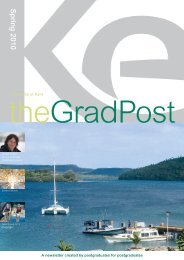SCHOOL OF ENGLISH - University of Kent
SCHOOL OF ENGLISH - University of Kent
SCHOOL OF ENGLISH - University of Kent
You also want an ePaper? Increase the reach of your titles
YUMPU automatically turns print PDFs into web optimized ePapers that Google loves.
24<br />
www.kent.ac.uk/english<br />
TAUGHT MODULES (CONT)<br />
Medieval and Early Modern<br />
Studies modules<br />
The following modules are part<br />
<strong>of</strong> the MA in Medieval and Early<br />
Modern Studies programme,<br />
and are <strong>of</strong>ten available as optional<br />
modules for other School <strong>of</strong> English<br />
MA students. Please note that not all<br />
modules listed here necessarily run<br />
every year.<br />
For the most up-to-date information,<br />
please see: www.kent.ac.uk/mems/<br />
postgraduate/courses<br />
Before Shakespeare<br />
Few plays survive from the period<br />
when Shakespeare was beginning<br />
to write. This module examines<br />
this era <strong>of</strong> theatre and book<br />
history, beginning with the newly<br />
established market for printed fiction<br />
and looking at the foundations <strong>of</strong> the<br />
early theatres, before examining the<br />
major performance texts from the<br />
period: the Queen’s Men and the<br />
boy companies’ plays. You use<br />
a range <strong>of</strong> primary sources, as well<br />
as engage with the contemporary<br />
work on the original practices <strong>of</strong><br />
staging at Shakespeare’s Globe.<br />
Chaucer and Gower<br />
Introducing you to the poetry<br />
and poetics <strong>of</strong> two Middle English<br />
writers, Ge<strong>of</strong>frey Chaucer and John<br />
Gower, this module draws from their<br />
respective works, The Canterbury<br />
Tales and Confessio Amantis. You<br />
undertake a comparative analysis<br />
<strong>of</strong> these texts, with particular<br />
emphasis on what they have in<br />
common. Chaucer is the better<br />
known author, but Gower doubtless<br />
has a more urgent and candid<br />
political voice, dealing with serious<br />
and sensational human interests<br />
such as incest, social rebellion and<br />
homosexuality.<br />
Grand Designs and Intimate<br />
Liaisons: Life at Home in Early<br />
Modern England<br />
The household was the most<br />
important space in the kingdom in<br />
the 16th and 17th centuries; when<br />
England first learnt that ‘a man’s<br />
house was his castle’ and that<br />
the household was a ‘little<br />
commonwealth’. These ideas<br />
became an ideology – what<br />
happened in houses affected the<br />
nation. What effect did this have on<br />
everyday life? What was it like to live<br />
in an early modern house? How did<br />
the environment and material<br />
conditions <strong>of</strong> the household shape<br />
everyday activities? You examine<br />
local houses and objects and put<br />
them into a national context, and<br />
examine primary sources such as<br />
legal, religious and domestic texts.<br />
Making the News<br />
The early modern period witnessed<br />
a revolution in the business <strong>of</strong><br />
reporting the news. The periodical<br />
press, the first newspapers and<br />
the first news aimed at a popular<br />
readership all originated in this<br />
period. In this module, you explore<br />
the ways in which news was<br />
collected, produced, disseminated<br />
and consumed both commercially<br />
and non-commercially throughout<br />
the period and consider the function<br />
and significance <strong>of</strong> coteries and<br />
news networks.<br />
The Gothic Imagination: English<br />
Art and Literature in the Later<br />
Middle Ages<br />
Using a series <strong>of</strong> chronological case<br />
studies, this module looks at the art<br />
and literature <strong>of</strong> England between<br />
c1200–1500. You consider issues<br />
<strong>of</strong> patronage, production, and<br />
audience, as well as the complex<br />
relationships between orality, aurality,<br />
literacy and visual culture. Specific<br />
topics may include medieval<br />
London, the Gawain manuscript,<br />
visionary literature and devotional<br />
imagery, and the critique <strong>of</strong> images<br />
emerging from John Wycliffe’s<br />
(1328–1384) Lollardy movement.<br />
Shakespeare and Material<br />
Culture<br />
What were the original staging<br />
practices and material qualities <strong>of</strong><br />
theatrical performance that shaped<br />
Shakespeare’s drama? You consider<br />
the role <strong>of</strong> material culture outside<br />
the theatre in a partially literate<br />
society before mass production,<br />
examining the way it functioned<br />
to define gender and social<br />
differences between individuals.<br />
Word and Image in Tudor<br />
England<br />
The module is structured around<br />
a selection from six key topics:<br />
the poetry, portraiture, and ‘selffashioning’<br />
in Henrician and<br />
Elizabethan courts; ‘private’<br />
miniatures and sonnets; emblems<br />
and emblem books; iconomachy<br />
and iconoclasm; women and visualverbal<br />
culture; and death, elegies<br />
and funerary arts.


